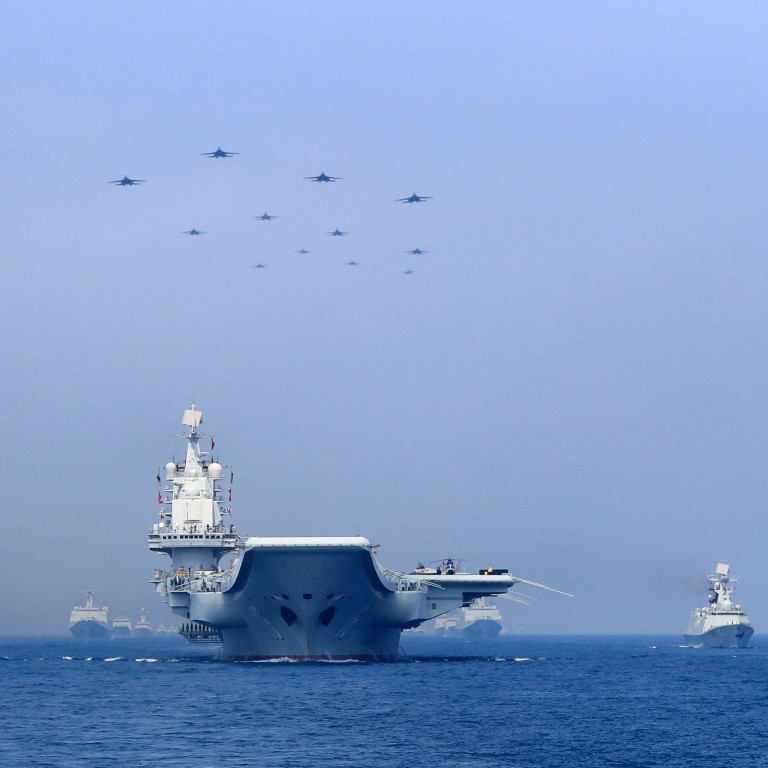
China’s aircraft carriers will operate in the world’s oceans, ex-colonel says
- Larger number of warships became necessary for missions further afield than South China Sea and Taiwan, retired senior colonel tells mainland media
- Aircraft carriers will appear on the high seas because, having acquired them, the country can hardly leave them in port, he says
China is building more vessels than it would need for operations close to its coast, because of its expanding overseas interests, a former Chinese colonel has said.
“The aircraft carrier itself is an open sea combat platform,” he was quoted as saying on Sunday by state-owned China Global Television Network. “It is impossible for us to design or manufacture such a large aircraft carrier and just put it at home.
“Therefore, in the future, Chinese aircraft carriers will definitely appear on the high seas of the world. The training for our aircraft carriers in the Pacific Ocean is going further and further, and has gone beyond the first island chain.”
The main security threats facing China were mainly from maritime areas, Zhou said, emphasising the navy’s increasing importance.
“Whether the threats are from the Taiwan Strait, the South China Sea or even the distant Indian Ocean, they are real,” he said.
Other nations have raised concerns about the Chinese navy’s expansion, and its deployment of aircraft carriers to a widening area. The Indian Armed Forces’ former chief of defence staff, Bipin Rawat, said in August that the Chinese aircraft carriers were not just for use in the Pacific or the South China Sea, and other countries needed to counter the threat.
China has an aggressive plan to build a real blue-water navy. It aims to build at least six aircraft carrier battle groups by 2035.
A Pentagon report last month said the Chinese navy was the world’s biggest maritime force, with 355 vessels. It said China was expected to expand the fleet to 420 ships in the next four years, and to 460 by 2030.
Last Thursday, a Type 071E landing platform dock and two Type 054 frigates were launched at the Hudong-Zhonghua Shipbuilding yard near Shanghai. China has in recent years deployed more warships to try to intimidate Taiwan – which it regards as a breakaway province – and to the South China Sea.
Zhou said that in the past the Chinese military put more focus on its land and air forces, and the combined tonnage of four Chinese vessels involved in the Battle of the Paracel Islands in 1974 was smaller than the largest warship of South Vietnam.
“If it is only to solve the problems near our border – whether it is the security of the South China Sea, or even the Taiwan issue – we don’t need so many warships,” Zhou said.
“The reason we have so many warships, including the development of aircraft carriers, is that we are going to the ocean. This is related to our huge national interests and our international responsibilities as a major country.”
Zhou said that China’s navy build-up would take account of Aukus – a pact through which the US and the UK will support Australia to acquire nuclear-powered submarines – but it was not a major consideration.
It is estimated that Australia will buy eight nuclear-powered submarines by 2040, by which time the Chinese navy will be further modernised.
“When we assess the military development of the Pacific countries, we must take this factor into account, but it is not decisive,” Zhou said. “I think it is not a big deal.”
Zhou said 13 years of participation by the Chinese navy in anti-piracy operations in the Gulf of Aden, where a single mission could last eight months, had made officers more familiar with conditions in international waters.
But he downplayed concerns that China could build more overseas military bases to add to the one in Djibouti, saying China’s overseas missions were for humanitarian and peacekeeping needs, in contrast to US ones that he said were for seeking dominance.



